





Herb gardens are a wonderful addition to your home garden! A wide variety of gardeners will find something to appeal to their interests, whether they love to cook, make flavorful teas, pamper themselves with home spa products, or just enjoy the additional wildlife that an herb garden can draw!
If you are ready to plant an herb garden of your very own, there are a very few key questions to consider before you start browsing the herbs at your local nursery or seed rack!
The first consideration in planning an herb garden of your own is what you ultimately want from your herbs. Are you interested primarily in culinary herbs? Do you have a craving for Italian foods, spicy Mexican flavors, or traditional French herbs? Do you make your own pickles? Do you love the scent of chamomile or lavender in your home?
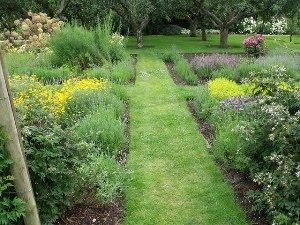
My own answers included all of the above, so my herb choices were fairly eclectic. I included the most popular Italian herbs, basil and oregano, as well as cilantro for my homemade salsa, chives for my potatoes and egg dishes, and a variety of other cooking herbs, including parsley, sage, rosemary,and thyme. (You are all humming the Simon and Garfunkel song now, aren't you?) I also planted two varieties of lavender for the scent, some dill for my pickles, and some bronze fennel, just for the swallowtail butterflies I see drifting through my flower beds on a regular basis. It is one of their host plants, and is also wonderfully fragrant when you brush up against it.
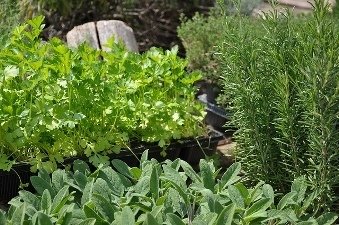
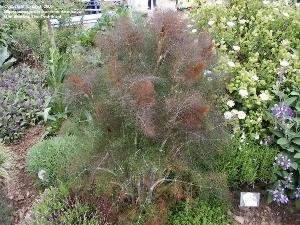
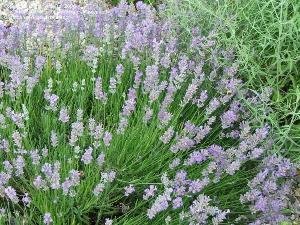
The next consideration is how much space you have to devote to your herbs. You can create a dedicated herb garden, or you can incorporate herbs into your other garden beds. Some herbs are perennial, such as lavender, oregano, chives, and sage, and need to be planted either in a permanent location, or in pots. They would not be appropriate for planting within a vegetable garden that is tilled every year.
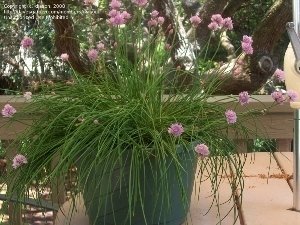 I learned (the hard way!) that chives can spread through your gardens if planted in the ground, so I dug a hole and sank a large clay pot in the ground, with the top 1-1/2 inches extending above ground level, and planted the chives inside of that. They don't have a very deep root system, since they have onion-like bulbs underground. They have been happily producing stems and blooms in the pot for the past ten years, with no additional attention. The only problem I've had with the idea is that I put it too near the border of my herb garden, and my son ran over the edge of the pot with the lawn mower and shattered it. Fortunately, the clump seems to be behaving and staying within the confines of the broken pot. Mint can also be quite an aggressive spreader, so is best planted in a pot or in a defined, limited area, such as one bordered by a sidewalk or stone wall. I tried the same idea, burying a clay pot with some mint near the border of my garden, and the mint sent runners out that escaped the pot and invaded the oregano nearby. I eventually dug up a clump and placed it into a free-standing pot, and haven't had any issues since.
I learned (the hard way!) that chives can spread through your gardens if planted in the ground, so I dug a hole and sank a large clay pot in the ground, with the top 1-1/2 inches extending above ground level, and planted the chives inside of that. They don't have a very deep root system, since they have onion-like bulbs underground. They have been happily producing stems and blooms in the pot for the past ten years, with no additional attention. The only problem I've had with the idea is that I put it too near the border of my herb garden, and my son ran over the edge of the pot with the lawn mower and shattered it. Fortunately, the clump seems to be behaving and staying within the confines of the broken pot. Mint can also be quite an aggressive spreader, so is best planted in a pot or in a defined, limited area, such as one bordered by a sidewalk or stone wall. I tried the same idea, burying a clay pot with some mint near the border of my garden, and the mint sent runners out that escaped the pot and invaded the oregano nearby. I eventually dug up a clump and placed it into a free-standing pot, and haven't had any issues since.
Other herbs are annuals, and must be replanted every year. Basil, dill, parsley, and marjoram, among many others, fall into this category. Rosemary is considered a tender perennial; however, I can't seem to get a rosemary plant to live past a year old, even when I plant them in a pot and bring them inside for the winter, so I treat them as annuals, as well. It is easy to include annual herbs in your vegetable garden, or to interplant them with your flowering annual border. Some are very pretty in their own right, like the purple varieties of basil.
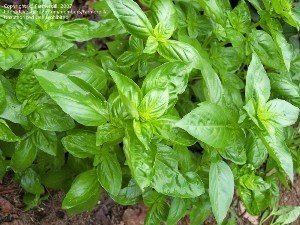 I do a combination method. I have a specific "herb garden" area where my perennial herbs are planted, along with individual specimens of the annual varieties. This is great for when I want to snip many different herbs at once. I just carry my colander and kitchen shears out with me, and in one stop, collect enough herbs to flavor a sauce, season our fish, or add complexity to our soup.
I do a combination method. I have a specific "herb garden" area where my perennial herbs are planted, along with individual specimens of the annual varieties. This is great for when I want to snip many different herbs at once. I just carry my colander and kitchen shears out with me, and in one stop, collect enough herbs to flavor a sauce, season our fish, or add complexity to our soup.
I also plant several annual culinary herbs in my vegetable garden. I often plant a little patch of dill, to use in my pickles. I always plant whole rows of basil among my tomatoes, because I make huge batches of roasted tomato sauce to freeze every year. I plant a partial row every 2 weeks in late spring/early summer, to extend the period of time when the basil is at its peak. Basil is often recommended for companion planting with tomatoes, to repel pests like tomato hornworms.
If you have space to plant a permanent herb garden, your next question is one of design. This is entirely a matter of personal taste and function. You can design a "cottage style" kitchen garden, where you loosely group the herbs based on height and color, and allow them to spread and self-seed to create a merry mass of fragrant herbs. I suggest leaving a little extra space between plants, to allow them room to grow to full maturity and spread. My main herb beds are in two locations; one just outside my back door for my most frequently used herbs, and another, more extensive one that extends in a long strip along one edge of our property. It began as an herb garden, and gradually became a blended herb/butterfly garden, with a mix of plants.
If space is at a premium, you can grow herbs in nearly any situation. Many stay small enough to grow happily in a collection of pots or window boxes, as long as they get adequate sunlight. Raised beds are another excellent option, if you have room for them.
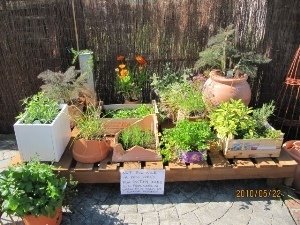
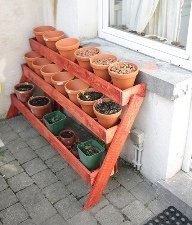
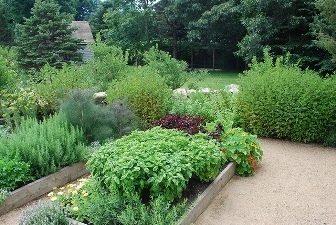
If you have more space, and the inclination to design a garden with a little more maintenance, you can create an herb garden with any one of many traditional designs. In Europe, traditional herb gardens were often based on geometric shapes. They often included permanent elements like paths, sun dials, fountains, and benches, and often used hedges to define specific areas and shapes within the garden. The herbs were planted in masses, to make a striking visual impact. Herb gardens were often part of a larger kitchen garden, which would include other greens, vegetables, and edibles in a complex design. You can design your own geometric pattern to fit any space you have available. The main considerations in any decorative design would be the amount of maintenance it will take to keep the design looking attractive, and the ability to harvest the herbs without destroying the visual effect you desire. I made this diagram quickly on the garden layout website, PlanGarden, to demonstrate some classic herb garden designs:
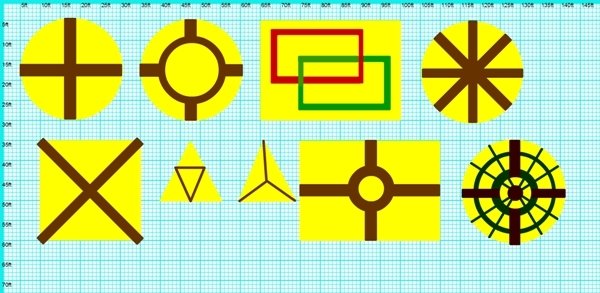
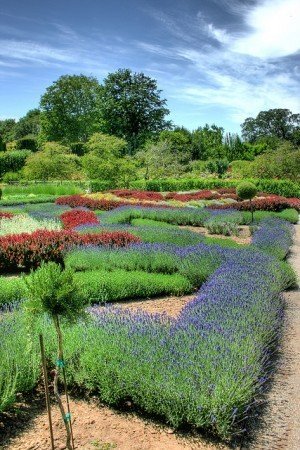
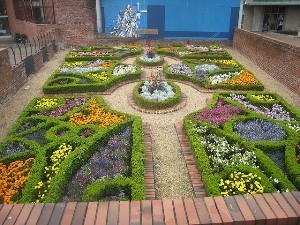
Another popular traditional herb garden design is based on a square or circle divided into four quarters by a path, which leads to a central circular area with a sun dial or fountain. Each quarter can be further subdivided into geometric shapes, with related herbs in each quarter. One important consideration in this design is that you are able to reach all of the herbs from the paths, or include stepping stones or standing areas within the quarters, so you are able to keep them weed-free, and harvest the herbs.
An attractive space-saving option is an herb spiral. A quick search online will lead you to several step-by-step tutorials on how to create your own herb spiral. The widest part of the spiral is at ground level, and then the design follows an incline that rises gradually to the highest point at the center. Unlike the formal, geometric herb garden designs, this one is very adaptable for the home gardener, and can be installed in a fairly small amount of space. See the first image at the start of the article for another example of a spiral garden using rocks instead of bricks to define the shape.
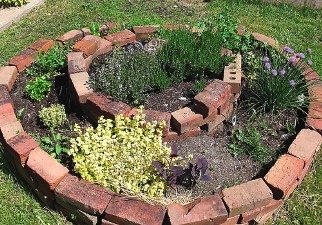
I have found that my herb garden is my favorite area to weed. Brushing up against the herbs in the process of searching out weeds releases their intense fragrances. I am often inspired to gather a handful of whatever is at its peak, and then decide what to make for dinner based on what is fresh and in season. I would encourage you to start small, with a few favorite herbs, and see where your heart leads you!
There is a wealth of information available about herbs here on Dave's Garden. In the box below the author bio, at the bottom of this article, note the line that reads, "Read articles about: Herbs" to see a list of all articles on Dave's Garden about herbs or herb gardening. You can also access the article search page here: Article Search Page. Type in the name of whatever herb catches your fancy to see any relevant articles. You can also search out hundreds of cultivars of herbs by searching for them in PlantFiles. There is also an entire forum dedicated to herbs, though it is only open to paid subscribers. The accumulated knowledge of the members of this site is amazing, if you only know how to locate it!
You can click on any image within the body of this article. Those of individual herbs, from PlantFiles, will take you to the entry for that herb. Images of gardens from Flickr will take you directly to the original image where you can view it full-sized, in line with the Flickr Creative Commons terms of service. Special thanks to the photographers for making their images available!
Photo Credits:
Spiral Garden thumbnail at start of article: amberdc, via Flickr Creative Commons. Some Rights Reserved.
With grass paths: ell brown, via Flickr Creative Commons. Some Rights Reserved.
Mixed herbs: by Salvadonica, Chianti, Tuscany, via Flickr Creative Commons. Some Rights Reserved.
Bronze Fennel: by DG member Saya, from PlantFiles
English Lavender: by DG member Marilynbeth, from PlantFiles
Potted chives: by DG member diason, from PlantFiles
Basil: by DG member Farmerdill, from PlantFiles
Assorted potted herbs: by wallygrom, via Flickr Creative Commons. Some Rights Reserved.
Spice Rack pots: by magnus franklin, via Flickr Creative Commons. Some Rights Reserved.
Raised beds: by JodiGrundig, via Flickr Creative Commons. Some Rights Reserved.
Garden plan layout: by Angela Carson, created with the online garden layout program on the PlanGarden website
Geometrical garden: by Double Down, via Flickr Creative Commons. Some Rights Reserved.
Knot Garden: by Jill Clardy, via Flickr Creative Commons. Some Rights Reserved.
Spiral Garden with brick edging: by Janice Mansfield, via Flickr Creative Commons. Some Rights Reserved.
Copyright © www.100flowers.win Botanic Garden All Rights Reserved